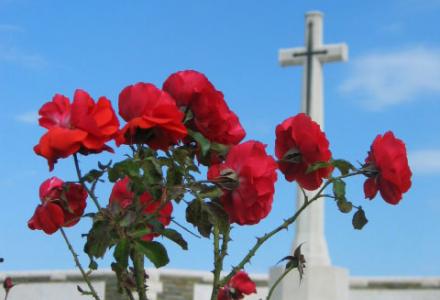We don’t know why Rufus and Cyril Rigney, Ngarrindjeri men from the Port Macleay Mission, chose to join up. Perhaps it was the hope of something better than toiling on a farm; perhaps—as for many white recruits—the lure of travel and adventure. In Rufus’ case at least, it may have been a sense of family obligation at the core of Aboriginal culture. Cyril signed up in April 1916 and followed his elder brother to war four months later. Both lads were only nineteen. Had they been white, they would have required their father’s consent, but the Protector of Aborigines—not the boys’ parents—was deemed to be the legal guardian of all Indigenous people. William Garnet South, a man Rufus had probably never met, duly signed his papers.
It turned out to be his death warrant. Cyril was killed at Messines in 1917. Rufus died at Passchendaele three months later.
We know little of the circumstances of Cyril’s death—or where his remains were recovered from the battlefield. Like thousands of other troops, from all over the world, the body of this Ngarrindjeri man was swallowed up by the Ypres salient. Rufus was initially reported missing rather than killed in action and the uncertainty regarding his fate prompted a series of Red Cross Inquiries. ‘He was wounded in the hop over at Passchendaele’, George Fox told the authorities, ‘shot through the lungs, … [he] was left in a shell hole’. Another of his comrades hurried to wrap a bandage around the wound but the lad was ‘very bad’. Private Rigney died not long after in the hands of the Germans.
Almost ninety years after the brothers left Australia, Victor and Verna Koolmatrie journeyed to Belgium. They carried part of their country with them—sand from the dunes of Ninety Miles Beach, earth from the Banks of the Coorong, soil gathered from the shores of Lake Alexandrina and the edges of the Murray. The parcel of soil was scattered on the moist turf of Harelbreke New British Cemetery where one of the two boys was buried; the distinctive notes of a didgeridoo cried out across Flanders Fields to the other. Clad in red paint and loincloth, Victor performed the dance of the kangaroo and the emu. It was a freezing winter’s morning but the great-great nephew of Rufus Gordon Rigney leapt high into the frosty air and landed close by his grave. And as Verna Koolmatrie spoke, that cold place seemed a little warmer.
Ngarrindjeri people will always remember Rufus and Cyril Rigney, just as they will always care for the country that they came from. The grieving began in the church where the two boys were taught the Bible. Today a memorial window shines in their honour. Nine from that mission went away to war, fighting, the stained glass tells us, not just for ‘King and Empire’ but ‘For Justice and Freedom’.
We do not know the number of Aboriginal people who lost their lives in the Great War—nor the number who fought for the country that long denied them citizenship. We do know that ‘Justice and Freedom’ has been a long time coming for Indigenous Australians—and that the service of Rufus and Cyril Rigney was one of many sacrifices.
The Rigneys’ story reminds us that Aboriginal and Torres Strait Islander service in the Great War remains—for the most part—a hidden history. White authorities failed to record Aboriginal descent in the official record, let alone Indigenous testimony. Even so, World War One is seen by many Indigenous people as one of many battles in the long road to equal citizenship. Recovering those stories today is an affirmation of culture and community.
For full attribution of sources, suggestions for further reading and an extended version of the story itself see ‘For justice and freedom: Cyril and Rufus Rigney’ in Bruce Scates, Rebecca Wheatley and Laura James, World War One: A History in 100 stories (Melbourne, Penguin/Viking, 2015) pp. 305-308; 363.



